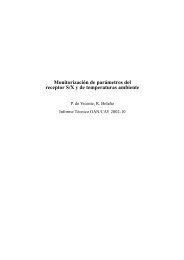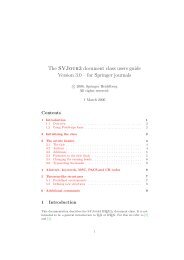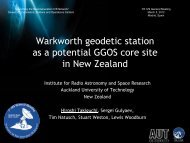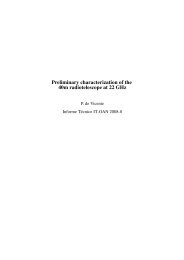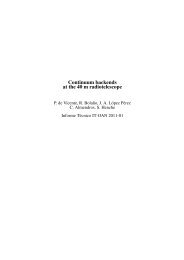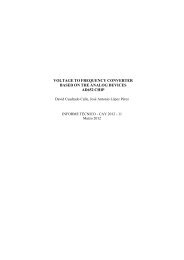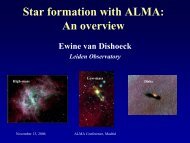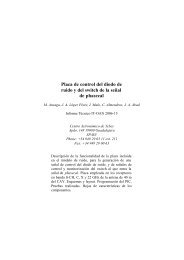Pointing models for the 40 m radiotelescope at 6, 8 and 22 GHz
Pointing models for the 40 m radiotelescope at 6, 8 and 22 GHz
Pointing models for the 40 m radiotelescope at 6, 8 and 22 GHz
Create successful ePaper yourself
Turn your PDF publications into a flip-book with our unique Google optimized e-Paper software.
<strong>Pointing</strong> <strong>models</strong> <strong>for</strong> <strong>the</strong><br />
<strong>40</strong> m <strong>radiotelescope</strong> <strong>at</strong> 6, 8 <strong>and</strong> <strong>22</strong> <strong>GHz</strong><br />
P. de Vicente<br />
In<strong>for</strong>me Técnico IT-OAN 2010-11
1<br />
Revision history<br />
Version D<strong>at</strong>e Author Upd<strong>at</strong>es<br />
1.0 07-04-2010 P. de Vicente First version
CONTENTS 2<br />
Contents<br />
1 Introduction 3<br />
2 Observing str<strong>at</strong>egy 3<br />
3 Open issues: Histeresis <strong>and</strong> double drifts 4<br />
4 The Nasmyth mirror effect 5<br />
5 D<strong>at</strong>a reduction 7<br />
6 <strong>Pointing</strong> <strong>at</strong> 6 <strong>GHz</strong> 8<br />
7 <strong>Pointing</strong> <strong>at</strong> <strong>22</strong> <strong>GHz</strong> 9<br />
8 <strong>Pointing</strong> <strong>at</strong> 8 <strong>GHz</strong> 13<br />
9 The tilt of <strong>the</strong> elev<strong>at</strong>ion axis 17<br />
10 Final results 20
1 INTRODUCTION 3<br />
1 Introduction<br />
This report describes results from several pointing sessions <strong>at</strong> 6, 8 <strong>and</strong> <strong>22</strong> <strong>GHz</strong>. The whole<br />
pointing session spanned more than two months. The procedure, described below, was iter<strong>at</strong>ive<br />
<strong>at</strong> <strong>the</strong> three frequencies. All observ<strong>at</strong>ions were per<strong>for</strong>med using continuum detector OAY14<br />
<strong>and</strong> an integr<strong>at</strong>ion time of 1 second. The simultaneous b<strong>and</strong>width used was th<strong>at</strong> of <strong>the</strong> frontend<br />
b<strong>and</strong>width: 500 MHz in <strong>the</strong> three cases. D<strong>at</strong>a were analyzed with CLASS in continuum mode.<br />
The <strong>40</strong> m antenna is a Nasmyth telescope with receivers in different loc<strong>at</strong>ions. The beam<br />
is directed towards <strong>the</strong> requested receiver by removing or inserting mirrors in <strong>the</strong> signal p<strong>at</strong>h.<br />
Each of <strong>the</strong>se Nasmyth mirrors introduce pointing errors <strong>and</strong> hence <strong>the</strong> pointing model should<br />
not necessarily be <strong>the</strong> same <strong>for</strong> all receivers. Barcia (see de Vicente & Barcia 2007) studied<br />
<strong>the</strong> influence of <strong>the</strong> misalignment of Nasmyth mirrors <strong>and</strong> horns on <strong>the</strong> pointing model of <strong>the</strong><br />
telescope. Parameters P 1 , P 2 , P 5 , P 7 , P 8 <strong>and</strong> P 9 may contain terms due to misalignments of<br />
optical elements after mirror M2 (<strong>the</strong> subreflector).<br />
As with technical report OAN-2010-10, <strong>the</strong> works regarding pointing were interrupted by<br />
<strong>the</strong> adjustement of <strong>the</strong> surface of <strong>the</strong> <strong>radiotelescope</strong>. There<strong>for</strong>e this report is a summary of <strong>the</strong><br />
st<strong>at</strong>us of <strong>the</strong> telescope by August 2010. Fur<strong>the</strong>r works will be per<strong>for</strong>med in <strong>the</strong> future since<br />
some issues regarding pointing are still open. These issues have been mentioned along this<br />
report <strong>and</strong> are rel<strong>at</strong>ed to <strong>the</strong> optimum position of <strong>the</strong> X b<strong>and</strong> <strong>and</strong> <strong>22</strong> <strong>GHz</strong> horns.<br />
2 Observing str<strong>at</strong>egy<br />
The aim of a pointing campaign is to obtain a good pointing model of <strong>the</strong> antenna, characterized<br />
in our case by a set of 8 parameters with a physical meaning. If <strong>the</strong>se parameters are unknown<br />
or poorly determined <strong>the</strong>y cause azimuth <strong>and</strong> elev<strong>at</strong>ion errors which depend on elev<strong>at</strong>ion <strong>and</strong><br />
azimuth <strong>and</strong> are proportional to <strong>the</strong> errors in <strong>the</strong> parameters. See de Vicente & Barcia (2007)<br />
<strong>and</strong> de Vicente (2008a) <strong>for</strong> <strong>the</strong> algorithm used in <strong>the</strong> <strong>40</strong> m. Parameters are obtained by least<br />
square analysis <strong>and</strong> <strong>the</strong> fit improves when <strong>the</strong> coverage of azimuth <strong>and</strong> elev<strong>at</strong>ion is best.<br />
<strong>Pointing</strong> campaigns are made of several sessions of pointing drifts on sources with different<br />
right ascention <strong>and</strong> declin<strong>at</strong>ion. The trajectory of each source on <strong>the</strong> sky allows to sample part<br />
of <strong>the</strong> sky. In order to maximize <strong>the</strong> sky coverage it is important to choose 5 or 6 bright sources<br />
whose declin<strong>at</strong>ions produce different elev<strong>at</strong>ions when <strong>the</strong>y transit <strong>the</strong> local meridian.<br />
There are two str<strong>at</strong>egies to observe several sources from <strong>the</strong>ir rise to <strong>the</strong>ir set: <strong>the</strong> simplest<br />
one is to track each source <strong>for</strong> a long time <strong>and</strong> <strong>the</strong>n proceed with <strong>the</strong> next one. A better str<strong>at</strong>egy<br />
is to per<strong>for</strong>m one double pointing scan on each source <strong>and</strong> repe<strong>at</strong> <strong>the</strong> cycle. Some sources<br />
will be over <strong>the</strong> horizon, <strong>and</strong> o<strong>the</strong>rs will be below <strong>at</strong> a given time. There<strong>for</strong>e <strong>the</strong> cycle <strong>at</strong> any<br />
time is done with those sources which are visible. This solution minimizes <strong>the</strong> observing time,<br />
provides a good sky coverage <strong>and</strong> prevents system<strong>at</strong>ic effects.<br />
Results in this report were obtained using both str<strong>at</strong>egies. We used <strong>the</strong> first observing mode<br />
<strong>at</strong> <strong>the</strong> beginning of <strong>the</strong> campaign. The second was used <strong>for</strong> more than half of <strong>the</strong> results presented<br />
here. Fig. 1 shows examples of <strong>the</strong> sky coverage <strong>for</strong> both str<strong>at</strong>egies. To <strong>the</strong> left, <strong>the</strong><br />
sources are tracked from rise to set <strong>and</strong> once a source is finished ano<strong>the</strong>r source is tracked. To<br />
<strong>the</strong> right, <strong>the</strong> antenna makes a double pointing drift on one source <strong>and</strong> <strong>the</strong>n moves to ano<strong>the</strong>r
3 OPEN ISSUES: HISTERESIS AND DOUBLE DRIFTS 4<br />
<strong>and</strong> this is repe<strong>at</strong>ed <strong>for</strong> 5 or 6 sources in total. This cycle is repe<strong>at</strong>ed <strong>for</strong> 24 hours <strong>and</strong> a good<br />
sky coverage is obtained after 1 day.<br />
Figure 1: Sky coverage using two different str<strong>at</strong>egies. X axis is azimuth <strong>and</strong> Y axis elev<strong>at</strong>ion. Left:<br />
Sources were tracked continuously from rise to set. The coverage took 4 days. Right: Sources were<br />
tracked altern<strong>at</strong>ively using a cycle. The coverage took 24 hours. The right one takes less time <strong>and</strong> avoids<br />
system<strong>at</strong>ic errors. No circumpolar sources where observed<br />
3 Open issues: Histeresis <strong>and</strong> double drifts<br />
The pointing model used in <strong>the</strong> <strong>40</strong> m telescope up to March 2010 was obtained by a manual<br />
fit, <strong>and</strong> it is described by de Vicente (2008b). This model has been used <strong>for</strong> 2 <strong>and</strong> a half years<br />
<strong>for</strong> all receivers since no solution <strong>for</strong> <strong>the</strong> elev<strong>at</strong>ion encoders problem (de Vicente et al 2010a)<br />
was found until 2010. After studying <strong>the</strong> problem <strong>and</strong> while we wait <strong>for</strong> fur<strong>the</strong>r results <strong>and</strong><br />
a definitive diagnostic <strong>and</strong> solution, elev<strong>at</strong>ion encoder 2 has been deactiv<strong>at</strong>ed <strong>and</strong> is no longer<br />
used in <strong>the</strong> position loop of <strong>the</strong> antenna. Deactiv<strong>at</strong>ion of encoder 2 reduces <strong>the</strong> hysteresis<br />
problem but does not solve it completely.<br />
Figure 2 shows <strong>the</strong> measured errors <strong>at</strong> several elev<strong>at</strong>ions <strong>at</strong> <strong>22</strong> <strong>GHz</strong> using only encoder 1.<br />
<strong>Pointing</strong> drifts moving previously <strong>the</strong> antenna from <strong>the</strong> horizon <strong>and</strong> from <strong>the</strong> zenith were done<br />
on 3C84, DR21 <strong>and</strong> Jupiter. The difference of pointing errors obtained coming from zenith <strong>and</strong><br />
from horizon (prior to making <strong>the</strong> pointing) versus elev<strong>at</strong>ion is depicted in th<strong>at</strong> figure. Errors<br />
decrease <strong>at</strong> high <strong>and</strong> low elev<strong>at</strong>ions <strong>and</strong> are larger <strong>at</strong> mid elev<strong>at</strong>ions. The maximum error caused<br />
by hysteresis using only encoder 1 is ≃ 14 ′′ <strong>and</strong> hence <strong>the</strong> pointing model accuracy is limited<br />
by this value. Real observ<strong>at</strong>ions may show errors lower than <strong>the</strong> previous value because <strong>the</strong>y<br />
depend on <strong>the</strong> previous position of <strong>the</strong> antenna.<br />
Double pointing drifts show a system<strong>at</strong>ic effect of unknown effect th<strong>at</strong> we hope to fix in <strong>the</strong><br />
future. The pointing error between a go <strong>and</strong> return drift is always half <strong>the</strong> space moved by <strong>the</strong>
4 THE NASMYTH MIRROR EFFECT 5<br />
Figure 2: Elev<strong>at</strong>ion pointing error difference between two pointing drifts on a source. On pointing drift<br />
was preceed by moving <strong>the</strong> driving from <strong>the</strong> zenith <strong>and</strong> <strong>the</strong> o<strong>the</strong>r by driving it coming from <strong>the</strong> horizon.<br />
<strong>Pointing</strong> errors are always higher when coming from <strong>the</strong> zenith. Encoder 2 was deactiv<strong>at</strong>ed<br />
antenna in <strong>the</strong> integr<strong>at</strong>ion time. It happens as if <strong>the</strong> source were always found 1/4 <strong>the</strong> integr<strong>at</strong>ion<br />
interval after it is expected. Figure 3 shows th<strong>at</strong> effect on azimuth <strong>and</strong> elev<strong>at</strong>ion drifts <strong>at</strong> <strong>22</strong> <strong>GHz</strong>,<br />
where <strong>the</strong> integr<strong>at</strong>ion interval is 10 ′′ . This effect should not have a relevant effect on <strong>the</strong> pointing<br />
model since <strong>the</strong> average is 0, but increases <strong>the</strong> d<strong>at</strong>a dispersion. The possible cause is a software<br />
bug which has not been identified yet.<br />
4 The Nasmyth mirror effect<br />
As st<strong>at</strong>ed in de Vicente & Barcia (2007), a receiver positioning error in a Nasmyth telescope<br />
causes modific<strong>at</strong>ions on pointing parameters P 1 , P 3 , P 8 <strong>and</strong> P 9 . We will describe here <strong>the</strong><br />
positioning error <strong>for</strong> a horn in a plane perpendicular to <strong>the</strong> direction of radi<strong>at</strong>ion after being<br />
reflected on a fl<strong>at</strong> Nasmyth mirror (M3 in our case) <strong>and</strong> on a second mirror with magnific<strong>at</strong>ion<br />
th<strong>at</strong> we will call M5.<br />
Let us assume a reference frame <strong>for</strong> a given horn, where X is an axis parallel to <strong>the</strong> ground<br />
<strong>and</strong> perpendicular to <strong>the</strong> direction of radi<strong>at</strong>ion <strong>and</strong> Y is an axis perpendicular to <strong>the</strong> ground <strong>and</strong><br />
perpendicular to <strong>the</strong> direction of radi<strong>at</strong>ion, <strong>and</strong> th<strong>at</strong> <strong>the</strong> horn is misplaced by a quantity δX <strong>and</strong><br />
δY . We will describe <strong>the</strong> effect of each mirror by a m<strong>at</strong>rix of two dimensions.<br />
M 5 does not make a rot<strong>at</strong>ion of <strong>the</strong> image, only increases or decreases <strong>the</strong> error along <strong>the</strong><br />
same axis by a factor m 5 . M 3 rot<strong>at</strong>es <strong>the</strong> plane as a function of elev<strong>at</strong>ion. Finally, an error in X<br />
<strong>and</strong> Y in M 2 is converted to a collim<strong>at</strong>ion error in azimuth <strong>and</strong> an offset in elev<strong>at</strong>ion respectively<br />
which depends on <strong>the</strong> equivalent focal length of <strong>the</strong> telescope:<br />
(<br />
δAz<br />
δEl<br />
)<br />
=<br />
(<br />
K/ cos el 0<br />
0 K<br />
) (<br />
cos el − sin el<br />
sin el + cos el<br />
) (<br />
m5<br />
0 m 5<br />
) (<br />
δX<br />
δY<br />
)
4 THE NASMYTH MIRROR EFFECT 6<br />
Figure 3: <strong>Pointing</strong> error difference between two subscans along <strong>the</strong> same direction (azimuth or elev<strong>at</strong>ion)<br />
but opposite sense <strong>at</strong> <strong>22</strong> <strong>GHz</strong>. Scans were 600 arcsecs long <strong>and</strong> had a sp<strong>at</strong>ial resolution of 10<br />
arcsecs per point. First subscan is always in increasing order along th<strong>at</strong> axis. The result is obtained by<br />
substracting <strong>the</strong> second subscan to <strong>the</strong> first one.<br />
where K = 1/f eq . The <strong>40</strong> m <strong>radiotelescope</strong> has an equivalent focal length of 316.6 m <strong>and</strong><br />
hence K(arcsecs/mm) = 3.16 10 −6 2.06 10 5 = 0.6. Multiplying <strong>the</strong> m<strong>at</strong>rixes we get:<br />
which could be written as:<br />
δAz = m 5 KδX − m 5 K tan el δY (1)<br />
δEl = m 5 K sin el δX + m 5 K cos el δY (2)<br />
δAz = P1 m5 + P3 m5 tan el (3)<br />
δEl = P8 m5 sin el + P9 m5 cos el (4)<br />
where <strong>the</strong> superscript “m5” st<strong>and</strong>s <strong>for</strong> Nasmyth mirror 5, <strong>and</strong> means th<strong>at</strong> <strong>the</strong>se coefficients come<br />
from a horn missalingment after mirror M 5 . Since pointing errors from CLASS are collim<strong>at</strong>ion<br />
errors we should use <strong>the</strong> following <strong>for</strong>mulae:<br />
δAz c = m 5 K cos el δX − m 5 K sin el δY (5)<br />
δEl = m 5 K sin el δX + m 5 K cos elδY (6)<br />
where δAz c is <strong>the</strong> pointing error <strong>for</strong> azimuth drifts in CLASS. δX increases when we move<br />
<strong>the</strong> horn towards <strong>the</strong> “right” as we see <strong>the</strong> vertex of <strong>the</strong> antenna from <strong>the</strong> horn. δY increases<br />
when we move <strong>the</strong> horn away from <strong>the</strong> ground. <strong>Pointing</strong> errors are proportional to <strong>the</strong> shift of<br />
<strong>the</strong> horn <strong>and</strong> to <strong>the</strong> magnific<strong>at</strong>ion of <strong>the</strong> antenna <strong>and</strong> depend on <strong>the</strong> elev<strong>at</strong>ion.
5 DATA REDUCTION 7<br />
The previous scenario is approxim<strong>at</strong>ely <strong>the</strong> one <strong>at</strong> <strong>the</strong> <strong>40</strong> m <strong>radiotelescope</strong>. In <strong>the</strong> case<br />
of <strong>the</strong> X receiver, behind M3 <strong>and</strong> M4 (a fl<strong>at</strong> mirror), <strong>the</strong>re is an offset parabola (M5) <strong>and</strong> a<br />
dichroic hiperbolic mirror. At C b<strong>and</strong> <strong>the</strong> dichroic hiperbolic mirror is removed. At <strong>22</strong> <strong>GHz</strong><br />
radi<strong>at</strong>ion goes straight from M4 across a hole in M5 <strong>and</strong> is reflected in a ano<strong>the</strong>r hiperbolic<br />
mirror be<strong>for</strong>e entering <strong>the</strong> horn. This means th<strong>at</strong> in all cases <strong>the</strong> equivalent focal distance is<br />
modified (shortened) using spherical mirrors <strong>and</strong> hence computing <strong>the</strong> correspondance between<br />
a physical displacement <strong>and</strong> an angular error is not straight<strong>for</strong>ward.<br />
5 D<strong>at</strong>a reduction<br />
D<strong>at</strong>a were written in CLASS <strong>for</strong>m<strong>at</strong> by <strong>the</strong> control system (de Vicente 2010c). The drifts were<br />
reduced using CLASS (version aug08a) in continuum mode <strong>and</strong> written in ASCII files with<br />
azimuth, elev<strong>at</strong>ion, drift type (azimuth or elev<strong>at</strong>ion) <strong>and</strong> <strong>the</strong> result of <strong>the</strong> fit per subscan. This<br />
version of CLASS allows to produce two <strong>for</strong>m<strong>at</strong>s: <strong>the</strong> FIT <strong>for</strong>m<strong>at</strong> <strong>and</strong> <strong>the</strong> POINT <strong>for</strong>m<strong>at</strong>. None<br />
of <strong>the</strong>m is completely useful <strong>for</strong> us since <strong>the</strong> first one contains <strong>the</strong> CLASS subscan identific<strong>at</strong>ion,<br />
azimuth <strong>and</strong> elev<strong>at</strong>ion <strong>at</strong> which <strong>the</strong> observ<strong>at</strong>ion was done <strong>and</strong> <strong>the</strong> fit result, <strong>and</strong> <strong>the</strong> second, <strong>the</strong><br />
scan identific<strong>at</strong>ion, <strong>the</strong> CLASS subscan identific<strong>at</strong>ion, type of pointing drift (we<strong>the</strong>r it is an<br />
azimuth or an elev<strong>at</strong>ion drift), azimuth <strong>and</strong> elev<strong>at</strong>ion <strong>at</strong> which <strong>the</strong> subscan was done <strong>and</strong> <strong>the</strong><br />
result of <strong>the</strong> fit result except <strong>the</strong> pointing error which is replaced by a collim<strong>at</strong>ion error with a<br />
buggy behaviour.<br />
To solve this issue <strong>the</strong> author wrote a simple python script which combines both files into<br />
one. The final file contains 14 columns: two scan identifiers, type of drift, azimuth, elev<strong>at</strong>ion,<br />
gaussian fit parameters with <strong>the</strong>ir errors, <strong>and</strong> <strong>the</strong> name of <strong>the</strong> source. This file is read by <strong>the</strong><br />
pointing reduction Java software written by Alonso et al. (2010). This applic<strong>at</strong>ion makes a fit<br />
to <strong>the</strong> observ<strong>at</strong>ions <strong>and</strong> displays <strong>the</strong> computed parameters <strong>and</strong> <strong>the</strong> results from <strong>the</strong> fit on top<br />
of <strong>the</strong> d<strong>at</strong>a in a graph. Observ<strong>at</strong>ions with erroneous results are edited within <strong>the</strong> applic<strong>at</strong>ion or<br />
previously with an editor. This report shows several figures produced by this applic<strong>at</strong>ion with<br />
results from <strong>the</strong> pointing model fit.<br />
Below we include <strong>the</strong> python script used to combine both file <strong>for</strong>m<strong>at</strong>s:<br />
import sys, string, os<br />
def main(args):<br />
fileIn1 = args[1]<br />
fileIn2 = args[2]<br />
fileOut = args[3]<br />
try:<br />
except:<br />
try:<br />
except:<br />
fIn1 = open(fileIn1,’r’)<br />
fIn2 = open(fileIn2,’r’)<br />
print "\nImposible abrir archivos de entrada %s %s" % (fileIn1, fileIn2)<br />
sys.exit(-1)<br />
fo = open(fileOut,’w’)<br />
print "\nImposible abrir el archivo de salida %s %s" % (fileOut)<br />
sys.exit(-1)
6 POINTING AT 6 GHZ 8<br />
line1 = fIn1.readline()<br />
line2 = fIn2.readline()<br />
while line1 != "" <strong>and</strong> line2 != "":<br />
#print line1, line2<br />
if line1[0] != ’!’ <strong>and</strong> line2[0] != ’!’:<br />
if "/" in line1 or "/" in line2:<br />
pass<br />
else:<br />
listLine1 = line1.split()<br />
listLine2 = line2.split()<br />
# 1159 19517 1 63.911 15.468 11.055 -3861.43 0.68 0 0 394.23 1.<br />
# 2890 62.1 34.9 0.120E+04 4.12 49.6 0.432 293. 1.06<br />
print listLine1<br />
print listLine2<br />
scanN = int(listLine1[0])<br />
gildasScan1 = int(listLine1[0])<br />
gildasScan2 = int(listLine2[0])<br />
if listLine1[2] == ’1’:<br />
drift = "Az"<br />
else:<br />
drift = "El"<br />
if gildasScan1 == gildasScan2:<br />
lineOut = "%s %s %s %s %s %s %s %s %s %s %s %s %s %s<br />
(listLine1[0], listLine1[1], listLine1[2], listLine1 [3], listLine1[4], \\<br />
listLine1[5], listLine2[5], listLine2[6], listLine1[8], listLine1[9], listLine1[10], \\<br />
listLine1[11], listLine1[12], listLine1[13], listLine1[14])<br />
fo.write(lineOut)<br />
line1 = fIn1.readline()<br />
line2 = fIn2.readline()<br />
fIn1.close()<br />
fIn2.close()<br />
fo.close()<br />
if __name__==’__main__’:<br />
main(sys.argv)<br />
6 <strong>Pointing</strong> <strong>at</strong> 6 <strong>GHz</strong><br />
The determin<strong>at</strong>ion of <strong>the</strong> new pointing model was first done <strong>at</strong> 6 <strong>GHz</strong>. The following sources<br />
were observed <strong>for</strong> 4 days in march 2010: J0319+415 (3C84), J0437+296 (3C123), J<strong>22</strong>53+161<br />
(3C274) <strong>and</strong> J0423-013. The sky coverage was not complete due to time restrictions <strong>and</strong> occupaince<br />
of <strong>the</strong> telescope, but we found it acceptable. Sources were chosen based on <strong>the</strong>ir<br />
brightness <strong>and</strong> distribution on <strong>the</strong> sky.<br />
Double pointing drifts were 2<strong>40</strong>0 ′′ long <strong>and</strong> lasted <strong>for</strong> 60 seconds. This provides a sp<strong>at</strong>ial<br />
resolution of <strong>40</strong> ′′ per point, which is roughly 14% of <strong>the</strong> HPBW. Double pointing drifts may<br />
gener<strong>at</strong>e a pointing difference of <strong>40</strong> ′′ between a drift in one direction <strong>and</strong> <strong>the</strong> opposite.<br />
Figures 4 <strong>and</strong> 5 display <strong>the</strong> azimuth <strong>and</strong> elev<strong>at</strong>ion errors as a function of azimuth <strong>and</strong> elev<strong>at</strong>ion<br />
<strong>and</strong> <strong>the</strong> predicted errors <strong>for</strong> <strong>the</strong> computed pointing parameters. After determining <strong>the</strong> new<br />
pointing parameters, <strong>the</strong>y were included in <strong>the</strong> antenna pointing model <strong>and</strong> <strong>the</strong> pointing session<br />
was repe<strong>at</strong>ed again. Parameters <strong>and</strong> <strong>the</strong> rms of <strong>the</strong> fit be<strong>for</strong>e <strong>the</strong> model <strong>and</strong> after applying it are<br />
summarized in Table 1. Errors from <strong>the</strong> second iter<strong>at</strong>ion are displayed in Figures 6 <strong>and</strong> 7.<br />
The parameter residual (< σ(P ) >) is defined as <strong>the</strong> mean (geometric) variance of each<br />
parameter. The mean devi<strong>at</strong>ion (σ(dev)) is <strong>the</strong> rms of <strong>the</strong> difference between <strong>the</strong> d<strong>at</strong>a <strong>and</strong> <strong>the</strong>
7 POINTING AT <strong>22</strong> GHZ 9<br />
Figure 4: Left: Elev<strong>at</strong>ion error versus azimuth <strong>at</strong> 6 <strong>GHz</strong>. Right: Elev<strong>at</strong>ion error versus elev<strong>at</strong>ion <strong>at</strong> 6<br />
<strong>GHz</strong>.<br />
Figure 5: Left: Azimuth error versus elev<strong>at</strong>ion <strong>at</strong> 6 <strong>GHz</strong>. Right: Azimuth error versus azimuth <strong>at</strong> 6<br />
<strong>GHz</strong>.<br />
model computed from whole set of d<strong>at</strong>a.<br />
7 <strong>Pointing</strong> <strong>at</strong> <strong>22</strong> <strong>GHz</strong><br />
<strong>Pointing</strong> <strong>at</strong> <strong>22</strong> <strong>GHz</strong> was done on a set of 5 sources: J0319+415 (3C84), J1230+123 (3C274),<br />
J<strong>22</strong>53+161 (3C454.3), J0437+296 (3C123) <strong>and</strong> Jupiter. The starting pointing model was model<br />
(1) <strong>at</strong> 6 <strong>GHz</strong>. Sky coverage was a bit incomplete. The second block of observ<strong>at</strong>ions was per-
7 POINTING AT <strong>22</strong> GHZ 10<br />
Parameter Model (0) ∆ P (1) Model (1) ∆ P (2) Model (2)<br />
P 1 ( ′′ ) 2570 -42 2528 3 2531<br />
P 2 ( ′′ ) 54 58 112 -7 105<br />
P 3 ( ′′ ) 0 -30 -30 6 24<br />
P 4 ( ′′ ) 0 6 6 -3 3<br />
P 5 ( ′′ ) 0 11 11 -9 2<br />
P 7 ( ′′ ) -915 -154 -1068 4 -1064<br />
P 8 ( ′′ ) 0 114 114 -8 106<br />
P 9 ( ′′ ) 465 147 578 38 616<br />
< σ(P ) > ( ′′ ) 12 12<br />
σ(dev) ( ′′ ) 12 12<br />
Table 1: C b<strong>and</strong> pointing model. Model(0) is <strong>the</strong> starting pointing model. Model (1) is <strong>the</strong> result from<br />
<strong>the</strong> first iter<strong>at</strong>ion, Model (2) <strong>the</strong> result from <strong>the</strong> second iter<strong>at</strong>ion. Units are arcsecs<br />
Figure 6: Left: Elev<strong>at</strong>ion error versus azimuth <strong>at</strong> 6 <strong>GHz</strong>. Right: Elev<strong>at</strong>ion error versus elev<strong>at</strong>ion. Second<br />
(final) iter<strong>at</strong>ion.
7 POINTING AT <strong>22</strong> GHZ 11<br />
Figure 7: Left: Azimuth error versus elev<strong>at</strong>ion <strong>at</strong> 6 <strong>GHz</strong>. Right: Azimuth error versus azimuth <strong>at</strong> 6<br />
<strong>GHz</strong>. Second (final) iter<strong>at</strong>ion.<br />
<strong>for</strong>med after correcting <strong>the</strong> pointing model from session 1. Sources observed were: J1<strong>22</strong>9+020<br />
(3C273), J1230+123 (3C274), J0437+296 (3C123), DR21, <strong>and</strong> Jupiter. Each scan was composed<br />
of 4 subscans 600 arcsecs long th<strong>at</strong> lasted 60 seconds <strong>and</strong> <strong>the</strong> sp<strong>at</strong>ial resolution was 10<br />
arcsecs (14% of <strong>the</strong> HPBW). Two subscans were in azimuth <strong>and</strong> two in elev<strong>at</strong>ion. Results from<br />
both iter<strong>at</strong>ions are shown in table 2. All parameters were set free.<br />
Inspection of Figs. 8 <strong>and</strong> 9, shows th<strong>at</strong> elev<strong>at</strong>ion <strong>and</strong> azimuth error versus azimuth show<br />
a system<strong>at</strong>ic effect which <strong>the</strong> pointing model cannot correct. These d<strong>at</strong>a were obtained using<br />
<strong>the</strong> first str<strong>at</strong>egy described in section 2. Fur<strong>the</strong>r pointing sessions should be per<strong>for</strong>med using<br />
st<strong>at</strong>egy 2 <strong>and</strong> once <strong>the</strong> surface is adjusted after holography measurements. Severeal positions<br />
of <strong>the</strong> <strong>22</strong> <strong>GHz</strong> horn will be tested.<br />
Parameter Model (0) ∆ P (1) Model (1) ∆ P (2) Model (2)<br />
P 1 ( ′′ ) 2528 12 25<strong>40</strong> 1 2541<br />
P 2 ( ′′ ) 112 -24 88 4 92<br />
P 3 ( ′′ ) -30 24 -6 -6 -12<br />
P 4 ( ′′ ) 6 -1 5 -1 4<br />
P 5 ( ′′ ) 11 -4 7 1 8<br />
P 7 ( ′′ ) -1068 -20 -1088 6 -1082<br />
P 8 ( ′′ ) 114 0 114 -10 104<br />
P 9 ( ′′ ) 612 4 616 -6 610<br />
< σ(P ) > ( ′′ ) 7 7<br />
σ(dev) ( ′′ ) 18 9<br />
Table 2: <strong>22</strong> <strong>GHz</strong> b<strong>and</strong> pointing model. Model(0) is <strong>the</strong> starting pointing model. Model (1) is <strong>the</strong> result<br />
from <strong>the</strong> first iter<strong>at</strong>ion, Model (2) <strong>the</strong> result from <strong>the</strong> second iter<strong>at</strong>ion. Units are arcsecs
7 POINTING AT <strong>22</strong> GHZ 12<br />
Figure 8: Left: Elev<strong>at</strong>ion error versus azimuth <strong>at</strong> <strong>22</strong> <strong>GHz</strong>. Right: Elev<strong>at</strong>ion error versus elev<strong>at</strong>ion <strong>at</strong> <strong>22</strong><br />
<strong>GHz</strong>. Second (final) iter<strong>at</strong>ion.<br />
Figure 9: Left: Azimuth error versus elev<strong>at</strong>ion <strong>at</strong> <strong>22</strong> <strong>GHz</strong>. Right: Azimuth error versus azimuth <strong>at</strong> <strong>22</strong><br />
<strong>GHz</strong>. Second (final) iter<strong>at</strong>ion.
8 POINTING AT 8 GHZ 13<br />
8 <strong>Pointing</strong> <strong>at</strong> 8 <strong>GHz</strong><br />
While this report was been written, we discovered th<strong>at</strong> <strong>the</strong> X b<strong>and</strong> horn was incorrectly placed.<br />
The X b<strong>and</strong> cryost<strong>at</strong> may house two horns: an X b<strong>and</strong> horn <strong>and</strong> a Q b<strong>and</strong> horn (not installed yet<br />
by this time) <strong>and</strong> <strong>the</strong>y should be separ<strong>at</strong>ed by a distance of 170 mm. However <strong>the</strong> real distance<br />
is 150 mm. As a consequence <strong>the</strong> horn is shifted <strong>at</strong> least 10 mm from its optimum position<br />
along a line parallel to <strong>the</strong> elev<strong>at</strong>ion axis. Two more errors may be present. The support table<br />
where <strong>the</strong> cryost<strong>at</strong> is <strong>at</strong>tached may also have an error along th<strong>at</strong> same axis which ammounts up<br />
to 5 mm, but its sense is unknown <strong>and</strong> it may decrease or increase <strong>the</strong> previous error. Finally a<br />
third error is present: <strong>the</strong> horn is tilted in elev<strong>at</strong>ion from its optical axis.<br />
The horizontal error is visible by looking <strong>at</strong> <strong>the</strong> dichroic mirror <strong>and</strong> <strong>the</strong> X b<strong>and</strong> horn from<br />
M4 <strong>and</strong> using <strong>the</strong> supporting screws, <strong>the</strong> dichoric mirror <strong>and</strong> <strong>the</strong> parabolic mirror after M4 as<br />
a reference <strong>for</strong> <strong>the</strong> eye. In order to test this missalignment we made several measurements <strong>at</strong><br />
three different positions of <strong>the</strong> X horn to find its optimum position. The one with <strong>the</strong> maximum<br />
gain should be used.<br />
There is a second effect th<strong>at</strong> may impact pointing. It is caused by a faulty brake in <strong>the</strong><br />
motor th<strong>at</strong> raises <strong>and</strong> lowers <strong>the</strong> dichroic mirror. Its nominal position, when observing <strong>at</strong> X<br />
b<strong>and</strong>, is 703 mm. We have observed th<strong>at</strong>, in some cases, <strong>the</strong> dichroic mirror falls along its<br />
support mast several millimeters or even centimeters. To avoid th<strong>at</strong> this effect confused our<br />
measurements, we checked th<strong>at</strong>, during <strong>the</strong> pointing sessions, <strong>the</strong> mirror did not move from its<br />
nominal position.<br />
Figure 10: X b<strong>and</strong> horn, dichoric mirror <strong>and</strong> parabolic mirror. The table th<strong>at</strong> supports <strong>the</strong> cryost<strong>at</strong> can<br />
be moved along <strong>the</strong> X axis (magenta line). The shown position is -5.5 mm. Positions 0 <strong>and</strong> -11 mm are<br />
also shown in <strong>the</strong> image. The dichroic mirror is in its highest position <strong>and</strong> may be shifted along its mast.<br />
The picture is taken from M4, th<strong>at</strong> is, where radi<strong>at</strong>ion comes from.
8 POINTING AT 8 GHZ 14<br />
<strong>Pointing</strong> <strong>at</strong> 8 <strong>GHz</strong> was done on <strong>the</strong> following sources: J039+415, J1230+123, J0437+296,<br />
J1<strong>22</strong>9+020 <strong>and</strong> J0423-013. The starting pointing model was <strong>the</strong> final pointing model <strong>for</strong> <strong>22</strong><br />
<strong>GHz</strong>. Each scan was composed of 4 subscans 600 arcsecs long th<strong>at</strong> lasted 60 seconds <strong>and</strong> <strong>the</strong><br />
sp<strong>at</strong>ial resolution was 27 arcsecs (11% of <strong>the</strong> HPBW). Two subscans were in azimuth <strong>and</strong> two<br />
in elev<strong>at</strong>ion. Results from both iter<strong>at</strong>ions are shown in Table 3.<br />
Parameter Model (0) ∆ P (1) Model (1) ∆ P (2) Model (2)<br />
P 1 ( ′′ ) 2541 -2 2539 1 25<strong>40</strong><br />
P 2 ( ′′ ) 92 -12 80 6 86<br />
P 3 ( ′′ ) -12 -2 -14 30 16<br />
P 4 ( ′′ ) 4 4 8 -3 5<br />
P 5 ( ′′ ) 8 2 10 -4 6<br />
P 7 ( ′′ ) -1082 -43 -1125 5 -1120<br />
P 8 ( ′′ ) 104 12 116 -2 114<br />
P 9 ( ′′ ) 610 -12 598 2 600<br />
< σ(P ) > ( ′′ ) 12 11<br />
σ(dev) ( ′′ ) 30 30<br />
Table 3: X b<strong>and</strong> pointing model. Model(0) is <strong>the</strong> starting pointing model. Model (1) is <strong>the</strong> result from<br />
<strong>the</strong> first iter<strong>at</strong>ion (horn <strong>at</strong> 0.0 mm) <strong>and</strong> model (2) <strong>the</strong> result from <strong>the</strong> second iter<strong>at</strong>ion (horn <strong>at</strong> 0.0 mm) .<br />
Units are arcsecs<br />
Parameter Original val. δX = 0.0 mm δX = −5.5 mm δX = −10.5 mm<br />
P 1 ( ′′ ) 2539 -16 -17 -14<br />
P 2 ( ′′ ) 80 29 30 30<br />
P 3 ( ′′ ) 14 9 10 8<br />
P 4 ( ′′ ) 8 -3 -2 -2<br />
P 5 ( ′′ ) 10 -8 -5 -6<br />
P 7 ( ′′ ) -1120 194 118 155<br />
P 8 ( ′′ ) 116 -164 -93 -127<br />
P 9 ( ′′ ) 598 -90 -57 -74<br />
< σ(P ) > ( ′′ ) 12 12 12<br />
σ(dev) ( ′′ ) 30 30 30<br />
Table 4: X b<strong>and</strong> pointing model <strong>for</strong> 3 focus cases in which <strong>the</strong>re is a l<strong>at</strong>eral horn shift of 0.0 mm,<br />
-5.5 mm <strong>and</strong> -10.5 mm. Neg<strong>at</strong>ive values imply th<strong>at</strong> <strong>the</strong> horn moves away from <strong>the</strong> elev<strong>at</strong>ion axis. The<br />
horn values values are rel<strong>at</strong>ive to <strong>the</strong> nominal position. The used parameter values are in <strong>the</strong> first column.<br />
Columns 2, 3 <strong>and</strong> 4 contain corrections to be applied to values in <strong>the</strong> first column.<br />
Several pointing drifts were per<strong>for</strong>med moving <strong>the</strong> X b<strong>and</strong> horn to check <strong>the</strong> pointing effects<br />
of such displacements <strong>and</strong> <strong>the</strong> gain drop associ<strong>at</strong>ed to <strong>the</strong>m. The X b<strong>and</strong> horn was shifted along<br />
a line parallel to <strong>the</strong> elev<strong>at</strong>ion axis (<strong>and</strong> hence to <strong>the</strong> ground) by a total ammount of 20 mm. The<br />
first series of measurements were done towards 3C274 <strong>at</strong> an elev<strong>at</strong>ion range between 18 <strong>and</strong>
8 POINTING AT 8 GHZ 15<br />
20 degrees elev<strong>at</strong>ion approxim<strong>at</strong>ely with <strong>the</strong> horn in positions 10.0 mm, 0.0 mm, -5.5 mm <strong>and</strong><br />
-10.5 mm. The second series was per<strong>for</strong>med <strong>at</strong> an elev<strong>at</strong>ion range between 74 <strong>and</strong> 80 degrees<br />
towards 4C39.25 (a source three times weaker than <strong>the</strong> previous one). The d<strong>at</strong>a <strong>for</strong> each source<br />
were obtained in a time span of <strong>40</strong> minutes.<br />
According to equ<strong>at</strong>ions 5 <strong>and</strong> 6 <strong>the</strong> expected pointing errors, if <strong>the</strong> horn is moved only along<br />
<strong>the</strong> X axis, should be:<br />
δAz c = −m 5 cos el δX (7)<br />
δEl = −m 5 sin el δX (8)<br />
because a positive shift according to <strong>the</strong> table where <strong>the</strong> horn is mounted, is a movement to<br />
<strong>the</strong> left (see Fig. 10). Table 5 summarizes <strong>the</strong> results. As we can see <strong>the</strong>re, <strong>the</strong> d<strong>at</strong>a m<strong>at</strong>ch<br />
<strong>the</strong> previous <strong>for</strong>mulae. The proportionality constant is approxim<strong>at</strong>ely 1 ′′ /mm. The gain drop<br />
is about 28% <strong>at</strong> high elev<strong>at</strong>ions <strong>and</strong> 6% <strong>at</strong> low elev<strong>at</strong>ions. The maximum gain is <strong>at</strong>tained <strong>at</strong><br />
δX = −5.0 mm <strong>at</strong> low elev<strong>at</strong>ions <strong>and</strong> <strong>at</strong> δX = −10.5 mm <strong>at</strong> high elev<strong>at</strong>ions. This difference is<br />
consistent with <strong>the</strong> observed gain drop <strong>at</strong> X b<strong>and</strong> <strong>at</strong> different elev<strong>at</strong>ions discussed in de Vicente<br />
(2010b). The fact th<strong>at</strong> <strong>the</strong> best X position differs <strong>at</strong> low <strong>and</strong> high elev<strong>at</strong>ions may point to a tilt in<br />
<strong>the</strong> subreflector. This tilt may cause th<strong>at</strong> <strong>the</strong> focus of radi<strong>at</strong>ion traces a quarter of a circle in <strong>the</strong><br />
focal plane as <strong>the</strong> antenna moves from low elev<strong>at</strong>ions to high elev<strong>at</strong>ions, shifting <strong>the</strong> optimum<br />
position of <strong>the</strong> horn.<br />
δX (mm) T a (k) δAz c ( ′′ ) δEl( ′′ ) El ( ◦ )<br />
10.0 11.3± 0.3 11.5 21 19<br />
0.0 12.0± 0.3 23 28 18<br />
-5.5 12.0± 0.3 26 20 19<br />
-10.5 11.8± 0.3 30 20 20<br />
10.0 2.6± 0.3 20 -18 78<br />
0.0 3.1± 0.3 21 -7.5 74<br />
-5.5 3.5± 0.3 18 5.5 77<br />
-10.5 3.6± 0.3 17.5 5.0 79<br />
Table 5: Results from pointing drifts with X horn <strong>at</strong> different positions <strong>and</strong> <strong>at</strong> two elev<strong>at</strong>ions. The horn<br />
position is rel<strong>at</strong>ive to <strong>the</strong> nominal positions. Maximum antenna temper<strong>at</strong>ure is <strong>at</strong> -5.5 mm <strong>at</strong> 20 degrees<br />
elev<strong>at</strong>ion <strong>and</strong> -10.5 mm <strong>at</strong> 75 degrees elev<strong>at</strong>ion.<br />
As a conclusion from <strong>the</strong> l<strong>at</strong>ter measurements, <strong>the</strong> X b<strong>and</strong> horn will be loc<strong>at</strong>ed <strong>at</strong> -5.5 mm<br />
<strong>and</strong> <strong>the</strong> pointing model will be modified accordingly as summarized in Table 6. Results from<br />
<strong>the</strong> fit are in Figs. 11 <strong>and</strong> 12.<br />
Fur<strong>the</strong>r observ<strong>at</strong>ions will be per<strong>for</strong>med in <strong>the</strong> future to check if <strong>the</strong> subreflector is really<br />
tilted <strong>and</strong>, if so, how it affects <strong>the</strong> pointing <strong>and</strong> <strong>the</strong> best X b<strong>and</strong> horn position.
8 POINTING AT 8 GHZ 16<br />
Parameter Model<br />
P 1 ( ′′ ) 25<strong>22</strong><br />
P 2 ( ′′ ) 110<br />
P 3 ( ′′ ) -4<br />
P 4 ( ′′ ) 6<br />
P 5 ( ′′ ) 5<br />
P 7 ( ′′ ) -1007<br />
P 8 ( ′′ ) 23<br />
P 9 ( ′′ ) 541<br />
< σ(P ) > ( ′′ ) 12<br />
σ(dev) ( ′′ ) 30<br />
Table 6: Final X b<strong>and</strong> pointing model with <strong>the</strong> horn <strong>at</strong> -5.5 mm, obtained from a pointing session with<br />
6 radiosources.<br />
Figure 11: Left: Elev<strong>at</strong>ion error versus azimuth <strong>at</strong> 8 <strong>GHz</strong>. Right: Elev<strong>at</strong>ion error versus elev<strong>at</strong>ion <strong>at</strong> 8<br />
<strong>GHz</strong>. Horn in -5.5 mm.
9 THE TILT OF THE ELEVATION AXIS 17<br />
Figure 12: Left: Azimuth error versus azimuth <strong>at</strong> 8 <strong>GHz</strong>. Right: Azimuth error versus elev<strong>at</strong>ion <strong>at</strong> 8<br />
<strong>GHz</strong>. Horn in -5.5 mm.<br />
9 The tilt of <strong>the</strong> elev<strong>at</strong>ion axis<br />
The tilt of <strong>the</strong> azimuth axis of <strong>the</strong> antenna has a pointing effect on elev<strong>at</strong>ion <strong>and</strong> on azimuth via<br />
parameters P 4 <strong>and</strong> P 5 as follows:<br />
∆El = P 4 sin Az + P 5 cos Az<br />
∆Az = −P 4 cos Az tan El + P 5 sin Az tan El<br />
where P 4 is <strong>the</strong> tilt angle towards <strong>the</strong> West <strong>and</strong> P 5 towards <strong>the</strong> South, ∆El <strong>and</strong> ∆Az are <strong>the</strong><br />
elev<strong>at</strong>ion <strong>and</strong> azimuth errors <strong>and</strong> Az <strong>and</strong> El are <strong>the</strong> observed azimuth <strong>and</strong> elev<strong>at</strong>ion.<br />
Fig. 13 depicts <strong>the</strong> elev<strong>at</strong>ion error predicted from <strong>the</strong> pointing <strong>models</strong> <strong>at</strong> 6, 8 <strong>and</strong> <strong>22</strong> <strong>GHz</strong>.<br />
The tilt direction is a function of <strong>the</strong> r<strong>at</strong>io between P 4 <strong>and</strong> P 5 <strong>and</strong> its rel<strong>at</strong>ive signs <strong>and</strong> it is<br />
easily determined from <strong>the</strong> figure: <strong>the</strong> direction of tilt is where <strong>the</strong> elev<strong>at</strong>ion error is highest<br />
with a neg<strong>at</strong>ive sign. The magnitude of <strong>the</strong> tilt is given by <strong>the</strong> amplitude of <strong>the</strong> resulting curve<br />
<strong>at</strong> its maximum elev<strong>at</strong>ion error. According to this criterium <strong>the</strong> antenna is tilted 9 ′′ towards<br />
∼ 230 ± 14 degs. Th<strong>at</strong> is towards <strong>the</strong> South-West.<br />
This behaviour can be confirmed using both inclinometers installed in <strong>the</strong> <strong>40</strong> m antenna<br />
close <strong>and</strong> above <strong>the</strong> elev<strong>at</strong>ion encoders (Fig 14). Each inclinometer can be thought of as composed<br />
of a pendulum which measures <strong>the</strong> angle with a line perpendicular to <strong>the</strong> floor in two<br />
dimensions: X <strong>and</strong> Y. The Y axis is parallel to <strong>the</strong> elev<strong>at</strong>ion axis <strong>and</strong> <strong>the</strong> X axis is a horizontal<br />
line perpendicular to Y axis. For <strong>the</strong> time being its sense is unknown. The reference system<br />
moves with <strong>the</strong> inclinometer.<br />
In order to get <strong>the</strong> azimuth axis tilt, <strong>the</strong> antenna is turned <strong>at</strong> a constant velocity around <strong>the</strong><br />
azimuth axis. The results are shown in Fig. 15. The curves have been shifted along <strong>the</strong> Y
9 THE TILT OF THE ELEVATION AXIS 18<br />
Figure 13: Elev<strong>at</strong>ion error versus azimuth <strong>at</strong> 6, 8 <strong>and</strong> <strong>22</strong> <strong>GHz</strong>. The minimum happens towards <strong>the</strong><br />
direction of <strong>the</strong> tilt (≃ 230 degs). North is towards 0 degrees azimuth <strong>and</strong> East towards 90 degrees.<br />
Figure 14: Inclinometer (white box) above encoder 1 (black cylinder). This is <strong>the</strong> left side as seen from<br />
<strong>the</strong> receiver cabin.
9 THE TILT OF THE ELEVATION AXIS 19<br />
axis so th<strong>at</strong> <strong>the</strong> original position, be<strong>for</strong>e <strong>the</strong> antenna starts moving, read zero. This oper<strong>at</strong>ion is<br />
basically finding <strong>the</strong> offset <strong>and</strong> correcting it.<br />
It is expected th<strong>at</strong> when <strong>the</strong> antenna starts turning, Y positions from both inclinometers<br />
readouts increase (due to centrifugal <strong>for</strong>ce). The tilt should be visible on top of th<strong>at</strong> pl<strong>at</strong>eau.<br />
The <strong>the</strong>oretical expected curve from <strong>the</strong> inclinometers is a sinusoid. Results from <strong>the</strong> X axis<br />
<strong>and</strong> Y axis in each inclinometer should be similar but shifted 90 degrees in azimuth, since<br />
after a rot<strong>at</strong>ion of 90 degrees in azimuth, X <strong>and</strong> Y axis are interchanged with respect to a fixed<br />
reference frame. Results from inclinometer 1 <strong>and</strong> 2 should also be <strong>the</strong> same but shifted 180<br />
degrees. This is obvious since X axis <strong>at</strong> <strong>the</strong> left has an opposite sense to <strong>the</strong> axis <strong>at</strong> <strong>the</strong> right<br />
referred to a fixed reference frame. The same happens <strong>for</strong> Y axis.<br />
According to Fig. 15, Y axis show a maximum <strong>and</strong> a minimum where both curves differ<br />
most: ∼ 170 ◦ <strong>and</strong> ∼ 3<strong>40</strong> ◦ . The maximum <strong>and</strong> minimum <strong>for</strong> <strong>the</strong> X axis happen <strong>at</strong> ∼ 260 ◦ <strong>and</strong><br />
∼ 70 ◦ . As expected, <strong>the</strong> Y <strong>and</strong> X minimum <strong>and</strong> maximum pairs differ ∼ 180 ◦ <strong>and</strong> <strong>the</strong> values<br />
between <strong>the</strong> X <strong>and</strong> Y inclinometers differ ∼ 90 ◦ degrees. The azimuth axis should be <strong>the</strong>n tilted<br />
ei<strong>the</strong>r <strong>at</strong> an azimuth of ∼ 260 ◦ or <strong>at</strong> ∼ 70 ◦ . To find out which is <strong>the</strong> sense of <strong>the</strong> X axis we can<br />
observe th<strong>at</strong> when <strong>the</strong> antenna acceler<strong>at</strong>es to reach a stable speed, <strong>the</strong> X readout suffers a jump,<br />
due to inertia. The antenna started moving from −50 ◦ to positive values, <strong>and</strong> <strong>the</strong> readouts from<br />
X axis in both cases decreased suddenly. Th<strong>at</strong> means th<strong>at</strong> X axis <strong>at</strong> inclinometer in <strong>the</strong> right<br />
points towards <strong>the</strong> south when <strong>the</strong> antenna is <strong>at</strong> 0 ◦ . Th<strong>at</strong> is equivalent to saying th<strong>at</strong> it points<br />
in <strong>the</strong> sense of <strong>the</strong> rot<strong>at</strong>ion, when rot<strong>at</strong>ion is clockwise. If inclinometer 2 is <strong>at</strong> <strong>the</strong> right, while<br />
looking <strong>at</strong> <strong>the</strong> vertex from <strong>the</strong> receiver cabin, <strong>the</strong>n <strong>the</strong> antenna is tilted towards azimuth ∼ 260 ◦ .<br />
This value approxim<strong>at</strong>ely m<strong>at</strong>ches th<strong>at</strong> from <strong>the</strong> pointing model.<br />
Figure 15: Inclinometers results.<br />
The ammount of <strong>the</strong> tilt is approxim<strong>at</strong>ely <strong>the</strong> amplitude of each sinosuid. Averaging <strong>the</strong>
10 FINAL RESULTS 20<br />
four curves we get:<br />
Amp =<br />
29 + 18 + 27 + 23<br />
2 4<br />
= 12 ′′ ± 2 ′′ (9)<br />
Conclusion: According to <strong>the</strong> pointing model <strong>the</strong> azimuth axis is tilted 9 ′′ towards azimuth<br />
230 ◦ , while according to <strong>the</strong> inclinometers it is tilted 12 ′′ towards azimuth 260 ◦ .<br />
10 Final results<br />
Table 7 summarizes <strong>the</strong> pointing <strong>models</strong> <strong>for</strong> <strong>the</strong> three frequencies. The pointing model <strong>for</strong> X<br />
b<strong>and</strong> is <strong>the</strong> one obtained with <strong>the</strong> horn in position -5.5 mm. Models are roughly similar, being<br />
<strong>the</strong> most different <strong>the</strong> X b<strong>and</strong> one. Differences are signific<strong>at</strong>ive in P 7 , P 8 <strong>and</strong> P 9 .<br />
Parameter 6 <strong>GHz</strong> 8 <strong>GHz</strong> <strong>22</strong> <strong>GHz</strong><br />
P 1 ( ′′ ) 2531 25<strong>22</strong> 2541<br />
P 2 ( ′′ ) 105 110 92<br />
P 3 ( ′′ ) -24 -4 -12<br />
P 4 ( ′′ ) 3 6 4<br />
P 5 ( ′′ ) 2 5 8<br />
P 7 ( ′′ ) -1064 -1007 -1082<br />
P 8 ( ′′ ) 106 23 104<br />
P 9 ( ′′ ) 616 541 610<br />
Table 7: Current pointing <strong>models</strong> <strong>at</strong> <strong>the</strong> <strong>40</strong> m <strong>radiotelescope</strong>. X b<strong>and</strong><br />
The difference in parameters P 8 <strong>and</strong> P 9 are easily underst<strong>and</strong>able as arising from horn offsets<br />
in X <strong>and</strong> Y. However a difference in P 7 cannot be explained from an error after <strong>the</strong> Nasmyth<br />
mirror M3. We have tried to fix P 7 to a nominal vaue <strong>and</strong> fit <strong>the</strong> rest of parameters but<br />
this causes a clear wrong fit. We should investig<strong>at</strong>e fur<strong>the</strong>r why P 7 <strong>at</strong> X b<strong>and</strong> differs from <strong>the</strong><br />
pointing results <strong>at</strong> 6 <strong>and</strong> <strong>22</strong> <strong>GHz</strong>.<br />
New pointing <strong>models</strong> should be derived if we find th<strong>at</strong> <strong>the</strong> best position of <strong>the</strong> X b<strong>and</strong> <strong>and</strong><br />
<strong>22</strong> <strong>GHz</strong> horns differ from <strong>the</strong> current ones.<br />
References<br />
[Alonso et al. 2010] T. Alonso, P. de Vicente, V. Bujarrabal. ”Implement<strong>at</strong>ion of <strong>the</strong> pointing<br />
model <strong>for</strong> <strong>the</strong> <strong>40</strong>m OAN <strong>radiotelescope</strong>”. In<strong>for</strong>me Técnico OAN 2010-3. 2010<br />
[de Vicente & Barcia 2007] P. de Vicente, A. Barcia. ”Deconstructing a pointing model”. In<strong>for</strong>me<br />
Técnico OAN-2008-27. 2007<br />
[de Vicente 2008a] P. de Vicente. ”Checking <strong>the</strong> pointing corrections implement<strong>at</strong>ion <strong>for</strong> <strong>the</strong><br />
<strong>40</strong>m <strong>radiotelescope</strong>”. In<strong>for</strong>me Técnico OAN-2008-7. 2008
REFERENCES 21<br />
[de Vicente 2008b] P. de Vicente. ”Preliminary characteriz<strong>at</strong>ion of <strong>the</strong> <strong>40</strong>m <strong>radiotelescope</strong> <strong>at</strong><br />
<strong>22</strong> <strong>GHz</strong>”. In<strong>for</strong>me Técnico OAN-2008-8. 2008<br />
[de Vicente 2010a] P. de Vicente, K. M<strong>at</strong>ull, E. Sust, C. Albo. ”Encoder hysteresis <strong>at</strong> <strong>the</strong> <strong>40</strong>m<br />
<strong>radiotelescope</strong>” In<strong>for</strong>me Técnico OAN-2010-2. 2010<br />
[de Vicente 2010b] P. de Vicente. ”Characteriz<strong>at</strong>ion of <strong>the</strong> <strong>40</strong>m <strong>radiotelescope</strong> <strong>at</strong> 5, 6, 8 <strong>and</strong> <strong>22</strong><br />
<strong>GHz</strong>”. In<strong>for</strong>me Técnico OAN-2010-10. 2010<br />
[de Vicente 2010c] P. de Vicente. ”D<strong>at</strong>a acquisition <strong>and</strong> preliminary processing <strong>at</strong> <strong>the</strong> <strong>40</strong> m<br />
telescope”. In prepar<strong>at</strong>ion





